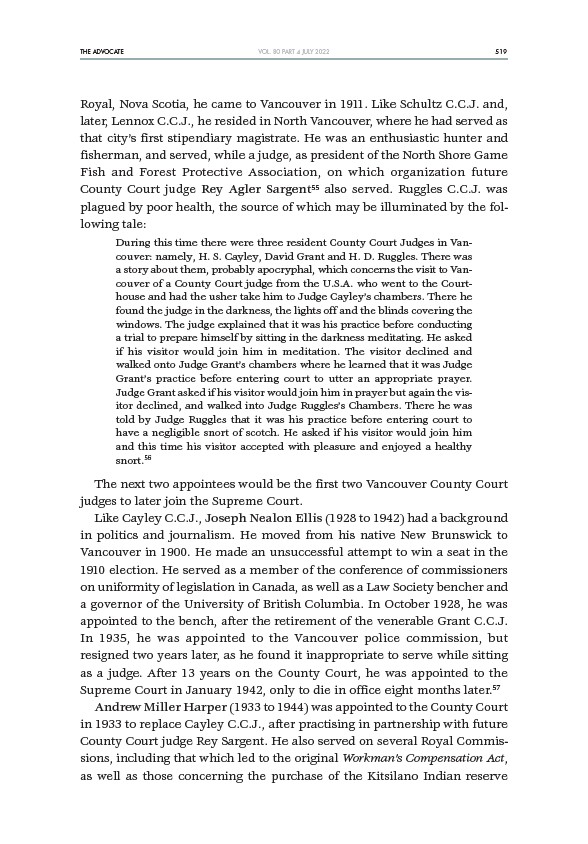
THE ADVOCATE 519
VOL. 80 PART 4 JULY 2022
Royal, Nova Scotia, he came to Vancouver in 1911. Like Schultz C.C.J. and,
later, Lennox C.C.J., he resided in North Vancouver, where he had served as
that city’s first stipendiary magistrate. He was an enthusiastic hunter and
fisherman, and served, while a judge, as president of the North Shore Game
Fish and Forest Protective Association, on which organization future
County Court judge Rey Agler Sargent55 also served. Ruggles C.C.J. was
plagued by poor health, the source of which may be illuminated by the following
tale:
During this time there were three resident County Court Judges in Vancouver:
namely, H. S. Cayley, David Grant and H. D. Ruggles. There was
a story about them, probably apocryphal, which concerns the visit to Vancouver
of a County Court judge from the U.S.A. who went to the Courthouse
and had the usher take him to Judge Cayley’s chambers. There he
found the judge in the darkness, the lights off and the blinds covering the
windows. The judge explained that it was his practice before conducting
a trial to prepare himself by sitting in the darkness meditating. He asked
if his visitor would join him in meditation. The visitor declined and
walked onto Judge Grant’s chambers where he learned that it was Judge
Grant’s practice before entering court to utter an appropriate prayer.
Judge Grant asked if his visitor would join him in prayer but again the visitor
declined, and walked into Judge Ruggles’s Chambers. There he was
told by Judge Ruggles that it was his practice before entering court to
have a negligible snort of scotch. He asked if his visitor would join him
and this time his visitor accepted with pleasure and enjoyed a healthy
snort.56
The next two appointees would be the first two Vancouver County Court
judges to later join the Supreme Court.
Like Cayley C.C.J., Joseph Nealon Ellis (1928 to 1942) had a background
in politics and journalism. He moved from his native New Brunswick to
Vancouver in 1900. He made an unsuccessful attempt to win a seat in the
1910 election. He served as a member of the conference of commissioners
on uniformity of legislation in Canada, as well as a Law Society bencher and
a governor of the University of British Columbia. In October 1928, he was
appointed to the bench, after the retirement of the venerable Grant C.C.J.
In 1935, he was appointed to the Vancouver police commission, but
resigned two years later, as he found it inappropriate to serve while sitting
as a judge. After 13 years on the County Court, he was appointed to the
Supreme Court in January 1942, only to die in office eight months later.57
Andrew Miller Harper (1933 to 1944) was appointed to the County Court
in 1933 to replace Cayley C.C.J., after practising in partnership with future
County Court judge Rey Sargent. He also served on several Royal Commissions,
including that which led to the original Workman’s Compensation Act,
as well as those concerning the purchase of the Kitsilano Indian reserve